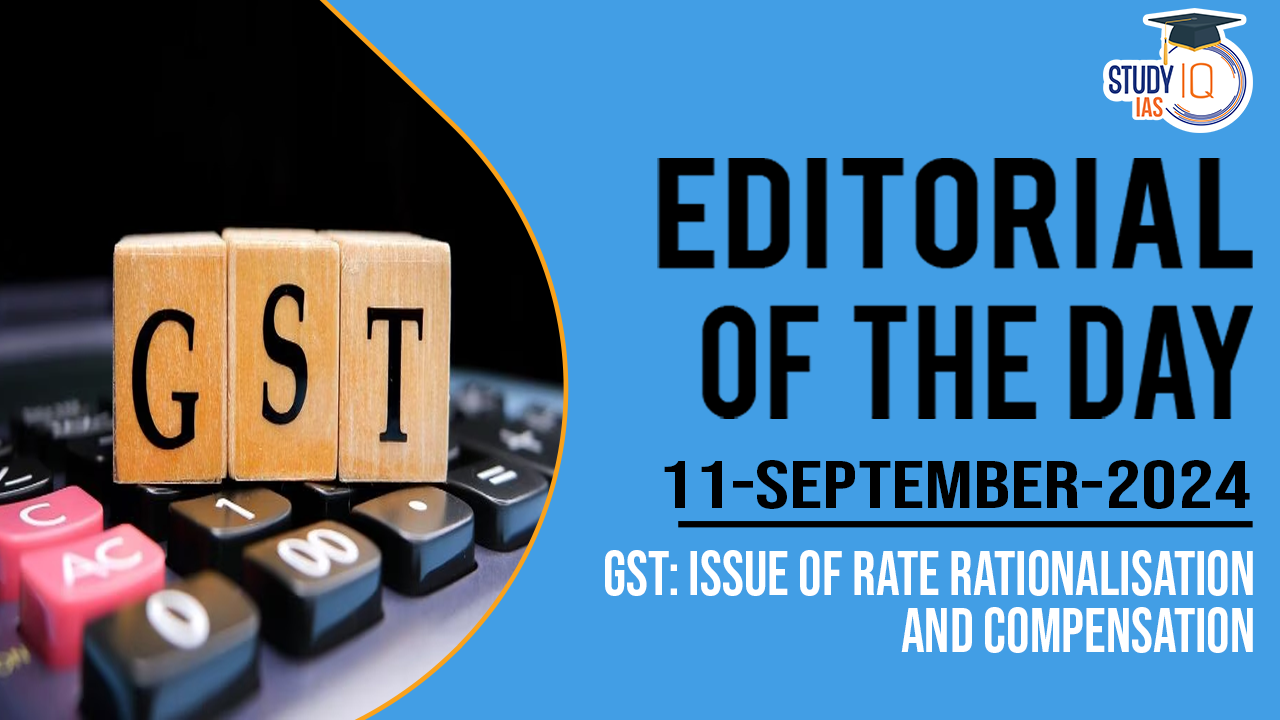Table of Contents
Context: Recently, the 54th GST Council meeting was held under the leadership of Union Finance Minister Nirmala Sitharaman.
Some Highlights of 54th GST Council Meeting
- Tax on extruded or expanded products was reduced from 18% to 12%.
- Exemption from income tax on research and development funds received by state or central universities or institutions was granted.
- The GST Compensation Cess was extended till March 2026.
- A Group of Ministers is expected to work on the rate rationalisation issue.
What is the GST Council?
- It is a joint forum consisting of representatives from both the Centre and the states.
- It was established by the President in accordance with Article 279A(1) of the amended Constitution.
- Members:
- Chairperson: Union Finance Minister
- Other Members: Union Minister of State for Finance
- Each state is allowed to nominate a minister responsible for finance, taxation, or any other relevant minister to represent them in the Council.
- Functions
- Responsible for recommending important GST-related matters to the Union and the states.
- This includes advising on which goods and services should be subjected to or exempted from GST and creating model GST laws.
- The Council also determines the various rate slabs for GST.
- Example: In 2024, it lowered the tax rate on certain cancer drugs (Trastuzumab Deruxtecan, Osimertinib, Durvalumab) from 12% to 5%.
- Responsible for recommending important GST-related matters to the Union and the states.
| Fact |
| Currently, GST is applicable in 4 slabs: 5%, 12%, 18% and 28%. |
What is GST Rate Rationalisation?
- GST rate rationalisation refers to the process of reviewing, revising, and simplifying GST rates for various taxable items.
- This is done during the GST Council’s quarterly meetings with members to streamline the tax structure.
- Purpose: To reduce complexity in the GST system and make it more efficient.
- Aims:
- Reducing GST rates for essential and semi-essential items.
- Shifting items from one tax category to another based on consumption patterns.
- Reducing the number of tax slabs to simplify the tax system.
- Eliminating confusion over different tax rates applied to similar items.
Why is there a need for Rationalisation?
- Structural Simplification of GST Rates: Many countries that have successfully implemented GST use only one or two tax slabs, indicating that there is significant room for improvement in India’s GST structure.
- Review Based on Consumption Patterns: Since GST is a consumption-driven tax, it is important to regularly review and revise rates in accordance with changing consumption patterns.
- Reducing Tax Burden on Essential Items: It plays a crucial role in lowering the tax burden on essential items, helping to curb price inflation.
- Minimising Compliance Burden: The presence of multiple tax slabs creates confusion and increases the compliance and audit burden for manufacturers and traders.
- Simplifying the tax rates through rationalisation can help reduce operational costs for businesses.
Impact of GST Rate Rationalisation
- Improve Ease of Doing Business: It will simplify tax processes for manufacturers and traders.
- Achieve “One Nation, One Market”: Removing interstate obstacles will facilitate smoother goods transfer across India.
- Reduce Compliance Burden: Manufacturers and traders will face fewer tax complexities and reduced compliance costs.
- Increase Voluntary Tax Compliance: A simplified GST structure will lead to higher taxpayer participation.
- Boost Government GST Collection: More efficient tax processes can result in increased revenues for the government.
Challenges in Rationalising GST Rates
- Diverse Consumption Patterns: India’s varied consumption habits across states make it challenging to build consensus on tax reforms.
- Two-thirds of voting rights in the GST Council belong to states, making alignment difficult.
- Impact on State Revenues: Proposals such as bringing petroleum products under GST face opposition from states that would lose revenue, creating political disagreements.
- Tax Collection Concerns: Any reduction in GST rates for certain goods must be offset by increases elsewhere.
- With luxury goods already taxed at high rates, there is limited room for adjustments without causing inflation.
- Inflation and Economic Impact: Merging the 12% and 18% slabs to a 15% median rate would increase the tax burden on goods currently taxed at 12%, potentially fueling inflation and impacting consumers.
- Implementation Complexity: Merging tax slabs requires cooperation between multiple government agencies, which is time-consuming and costly.
| Compensation Cess under GST |
|
Way Forward
- Consensus Building Among States: Engaging states in discussions about the impact of GST rationalisation on their revenues can help align interests.
- Gradual Implementation of Rate Changes: A phased approach to rationalising GST rates is recommended to avoid shocks.
- Addressing Revenue Concerns for States: To alleviate states’ revenue loss fears, compensatory mechanisms could be explored, such as allocating GST revenues to local bodies.
- Simplifying GST Classification: Focus on standardising product classifications to eliminate confusion and disputes.
- Example: resolving the classification issues between flavoured milk and beverages, which currently face different tax rates, will simplify compliance.
- Monitoring Economic Impact: Implement a monitoring framework to assess the economic impact of rate changes, particularly on inflation and consumer behaviour.


 Places in News for UPSC 2025 for Prelims...
Places in News for UPSC 2025 for Prelims...
 New Phase of Operation Chakra to Combat ...
New Phase of Operation Chakra to Combat ...
 Soyuz Aircraft: History, Design and Sign...
Soyuz Aircraft: History, Design and Sign...





















